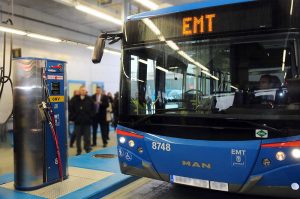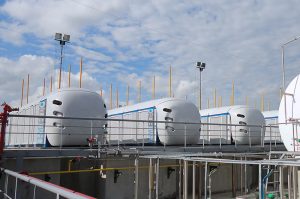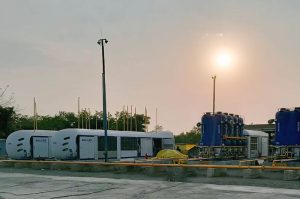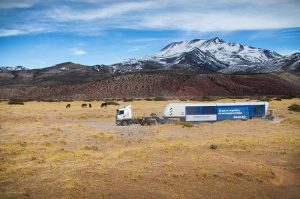A Visible Reduction in Emissions
The COVID-19 lockdown has shown what we can do, but will we be able to maintain this balance without stopping the entire world? Do LNG and Bio-LNG offer a path towards clean energy?
By Emilio Weber*
The year 2020 will be remembered in the history books as the year that COVID-19 brought the world to a standstill, but it will also be remembered as the moment the planet was able to take a deep breath. Whilst lockdown measures around the world stopped millions of people from working, with serious economic consequences for many countries, the crisis also brought about other changes that should give us hope for the future.
One of these was the change in the environment. Who wasn’t surprised to notice a clearer sky, less noise and even the return of wildlife to urban areas? In New Delhi, as in other cities with high levels of pollution, thick clouds of nitrogen dioxide had dulled the sky with its reddish-brown colour. However, in the week between 18th and 26th March, concentrations of NO2 fell more than 15-fold, and levels of fine particles (PM2.5) dropped by almost 70%. The lockdown in India began on the 24th March and lasted for 21 days.1
Variation in polluting emissions in New Delhi as a consequence of the lockdown
| Pollutant | Level of emissions 18th March 2020 |
Level of emissions 26th March 2020 |
Reduction | Maximum recorded in the 12 months prior to Lockdown |
| NO2 (μg/m3) | 19.93 | 1.21 | x 15 | 63 (20 Nov 19) |
| NOx (μg/m3) | 39.8 | 2.22 | x 18 | 203 (20 Nov 19) |
| PM2.5* | 58.92 | 19.34 | 67% | 491.6 (2 Nov 19) |
*Particulate Matter 2.5 or PM2.5 are very small particles in the air with a diameter of 2.5 micrometers (approximately 1 ten-thousandth of an inch) or less. It is one of the six categories of air pollution defined by the United States Environmental Protection Agency and is a mixture that can include organic chemical substances, dust, soot and metals. These particles can come from all manner of combustion, such as from vehicles, trucks, factories, wood-burning and agricultural burning.
To better understand these daily figures, it’s worth pointing out that the maximum daily concentration of PM2.5 accepted by the World Health Organization (WHO) Air Quality Guidelines (2005) and Directive 2008/50/CE of the European Union on ambient air quality is 25.2

Photos of the Gateway of India in New Delhi with data from the Central Pollution Control Board (CPCB) of India from their measurement station on Lodhi Road, Delhi (https://cpcb.nic.in/).
Besides these NO2, NOx and PM2.5 emissions (which are responsible for respiratory diseases, kidney problems and cancer), our atmosphere also contains increasingly high concentrations of carbon dioxide (CO2), which is one of the main causes of global warming.
Decarbonising: dream or reality
As a result of the lockdown and the slowdown in economic activity, global CO2 levels have been reduced to the same levels recorded in 20063. In fact, compared to the previous year, April saw a reduction of 17%.
However, sadly, if we don’t implement systemic and ecologically sustainable policies globally, gas emissions will quickly recover and be equal to or higher than pre-lockdown levels. This was what happened after the 2008 financial crisis, when CO2 emissions reduced by 2.1% in 2009 but increased by 4.5% the following year, reaching an all-time high.4
All this evidence shows us that reversing the damage to our environment is not some unrealistic fantasy and is something that we can do but frequently ignore in the pursuit of very short-term gains, for example, by continuing to use coal or not using incentives to stop gas flaring.
Coal still makes up almost 30% of the global energy mix5 and demand for it is growing in Asia. Meanwhile, natural gas is burnt when it could be used as a lower-emission alternative for generating electricity or as a substitute for coal or liquid fuels.
Without stopping the world: long-term benefits with LNG and Bio-LNG
Currently, natural gas is a commodity which is becoming an increasingly popular option around the world, and treatment and liquefaction technologies have solved the previous constraints on scale, making it more mobile, portable and scalable. As a result, the transportation of gas no longer solely depends on pipelines and seaports, being possible to transport it to any location in the form of liquefied natural gas (LNG) using trucks equipped with cryogenic ISO tanks.
By using LNG, a truck’s CO2 exhaust emissions are reduced by 20%, but if the truck consumes Bio-LNG, these emissions actually become carbon negative. Bio-LNG uses the same modular treatment and liquefaction technology but is obtained from sewerage waste and sludge. As a result, by using Bio-LNG, the overall carbon footprint is reduced. And since both options eliminate particulate matter (PM2.5), nitrogen oxide (NOx) and sulphur oxide (SOx) emissions, it’s clear that whatever we do with natural gas will put us on the right path towards cleaner air.
In summary, all of us have seen how air quality has improved in recent months because of reduced emissions. This is no longer just a debate about energy and climate change to be had between experts. Are we really going to just ignore this unexpected environmental experience when we already have the technology and clean energy to make it a permanent reality?
 |
*The author is the Commercial Vice-president at Galileo Technologies for Asia and the Pacific |
Notes:
[1] Central Pollution Control Board (CPCB), part of the Ministry of Environment, Forest and Climate Change of the Indian Government, https://cpcb.nic.in/.
[2] European Court of Auditors, Special Report on Air Pollution: Our health still insufficiently protected, 2018.
[3] Corinne Le Quéré, Robert B. Jackson, Matthew W. Jones, Adam J. P. Smith, Sam Abernethy, Robbie M. Andrew, Anthony J. De-Gol, David R. Willis, Yuli Shan, Josep G. Canadell, Pierre Friedlingstein, Felix Creutzig & Glen P. Peters, Temporary reduction in daily global CO2 emissions during the COVID-19 forced confinement, 19 May 2020.
[4] British Petroleum, BP Statistical Review of World Energy 2020, 69th Edition.
[5] IEA World Energy Balances 2019, https://www.iea.org/subscribe-to-data-services/world-energy-balances-and-statistics.
News

“Record-Breaking Station”: A decade of uninterrupted NGV supply in Spain
With NGV refueling technology developed by Galileo Technologies, Empresa Municipal de Transporte de Madrid continues to reduce its carbon footprint with 400 vehicles powered by clean energy.

Buquebus strengthens its alliance with Galileo Technologies by expanding its LNG manufacturing plant in Argentina
Thanks to Cryobox® technology, developed by Galileo for the liquefaction of natural gas, Buquebus will have a total of nine pieces of equipment in its manufacturing plant, which will result in an increase in production and efficiency in the generation of LNG in Buenos Aires.

India produces LNG for the first time with Galileo Technologies equipment
Thanks to the Cryobox technology, developed by Galileo for the liquefaction for Gail Limited India’s leading natural gas company, will be in charge of supplying LNG to both industries and public transport.

Galileo Technologies prepares for a new edition of Argentina Oil & Gas Expo
The company will offer its innovative compression, CNG, LNG, Bio-LNG and Bio-CNG solutions in September in Buenos Aires.